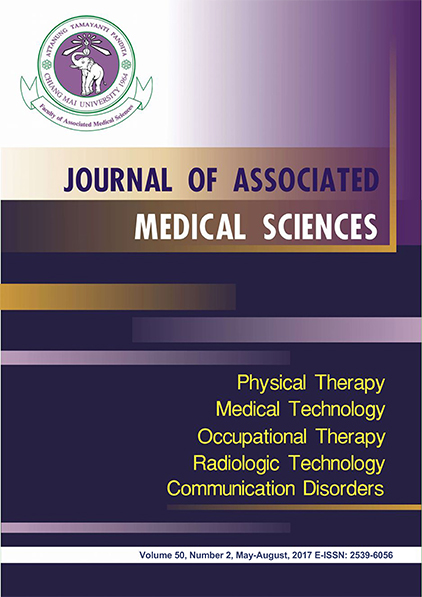Dosimetric comparison between manual and inverse optimization in brachytherapy planning for cervical cancer
Main Article Content
Abstract
Background: For image-guided brachytherapy (IGBT) for cervical cancer, manual optimization is normally used in routine practice. However, to define the dwell position and dwell time, experiences of the planner is the key factor. The inverse optimization which dwell weight and dwell time were calculated by computer was introduced to improve planning quality. However, evaluation of the benefit of inverse optimization in comparison to manual optimization is controversial.
Purpose: To compare dosimetric parameters between manual and inverse optimize planning for cervical cancer treated by IGBT.
Materials and methods: Forty-four CT-images set with inserted applicator of 11 cervical cancer patients were used. All patients were treated by teletherapy 50 Gy in 25 fractions and intracavitary brachytherapy with the 4 fractions of 7 Gy to D90 of HR-CTV. Manual and inverse algorithm IPSA method were used for optimization in all CT images set. Dose parameters to HR-CTV and organs at risk and optimization time consuming from both plans were compared and paired t-test was used to evaluate the difference.
Results: Inverse optimization plan significantly showed higher D90 of HR-CTV than manual method. For Organs at risk, inverse optimization showed higher dose of D2cc to bladder and rectum, but lower dose to sigmoid and bowel in comparison to manual method Moreover, the optimization time was lower for inverse planning.
Conclusion: The inverse optimize planning showed better target coverage dose and lower dose to bowels and sigmoid in the intracavitary planning. The inverse optimization time is significantly faster than manual optimization.
Journal of Associated Medical Sciences 2017; 50(2): 293-299. Doi: 10.14456/jams.2017.29
Article Details

This work is licensed under a Creative Commons Attribution-NonCommercial-NoDerivatives 4.0 International License.
Personal views expressed by the contributors in their articles are not necessarily those of the Journal of Associated Medical Sciences, Faculty of Associated Medical Sciences, Chiang Mai University.
References
2. Onal C, Arslan G, Erkan T, Pehlivan B, Tavuz M, Oymak E,et al. Comparison of conventional and CT-based planning for intracavitary brachytherapy for cervical cancer: Target volume coverage and organs at risk doses. Journal of Experimental & Clinical Cancer Research 2009; 28 (95): 1-10.
3. Potter R, Haie-Meder C, Limbergen EV, Barillot I, Brabandere MD, Dimopoulos J, et al. Recommendations from the gynaecological (GYN) GEC ESTRO working group (II): Concepts and terms in 3D image-based treatment planning in cervix cancer brachytherapy—3D dose volume parameters and aspects of 3D image-based anatomy, radiation physics and radiobiology. Radiotherapy and Oncology 2006; 78: 67-77.
4. Nucletron. Oncentra® External Beam v4.3 Oncentra® Brachy v4.3 170.730: Physics and Algorithms. 2009 (Pt7): 29-54.
5. Lessard E, Hsu IC, and Pouliot J. Inverse planning for interstitial gynecological template brachytherapy: Truly anatomy-base planning. International journal of radiation oncology biology physics 2002; 54 (4): 1243-51.
6. Reddy SS. Treatment planning and optimization in high-dose-rate brachytherapy. Journal of Cancer Research and Treatment 2013; 1 (2): 42-4.
7. Yoshio K, Murakami N, Morota M, Hadara K, Kitaguchi M, Seikii S, et al. Inverse planning for combination of intracavitary and interstitial brachytherapy for locally advanced cervical cancer. Journal of Radiation Research 2013; 54: 1146-1152.
8. Swamidas J, Kirisits C, Mahantshetty U, Tmkova P, Deshpande DD, Shrivastava SK, et al. Comparison of DVH parameters and loading patterns of standard loading, manual and inverse optimization for intracavitary brachytherapy on a subset of tandem/ovoid cases. Radiotherapy and Oncology 2010; 97: 501- 6.
9. Chajon E, Dumas I, Toulemat M, Magne N, Coulot J, Verstraet R, et al. Inverse Planning Approach for 3-D MRI-Based Pulse-Dose rate intracavitary Brachytherapy in cervix cancer. International journal of radiation oncology biology physics 2007; 69(3): 955-61.
10. Kirisits C, Trnkova P, Baltas D, Dimopoulos J and Potter R. Inverse Optimization for Cervix Cancer Brachytherapy Including Automatic Loading, DVH Optimization and Modification Restriction Adapted From Manual Planning. Medical Physics 2008; 35 (6): 2726.
11. Dewitt KD, Hsu C J, Joycelyn S, Weinberg VK, Lessard E and Pouliot J. 3D Inverse Treatment Planning for The Tandem and Ovoid Applicator in Cervical Cancer. International journal of radiation oncology biology physics 2005; 63(4): 1270-4.
12. Tmkova P, Baltas D, Karabis A, Stock M, Dimopoulos J, Georg D, et al. A detailed dosimetric comparison between manual and inverse plans in HDR intracavitary/interstitial cervical cancer brachytherapy. Journal of Contemporary Brachytherapy 2010; 2(4): 163-70.
13. KittikaK. Consideration sample size and strength of the test. Chiangmai: Textbook programม Faculty of Medicine Chiang Mai University; 2010 (in Thai).
14. Tharavichitkul E, Chakrabandhu S, Klunklin P, Onchan W, Chitapanarux I. Image-Based Brachytherapy in Cervical Cancer: Review and Experiences in Faculty of Medicine, Chiang Mai University. Journal of Cancer Therapy 2013; 4: 1-7.


